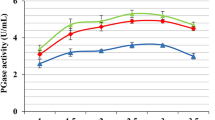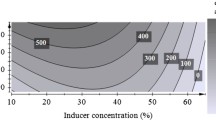Summary
Protein-extracted lucerne fiber was used as carbon and energy source for production of extracellular polygalacturonate lyase byThermomonospora curvata. The optimal fiber concentration was 1.5% (w/v); peal lyase activity in culture fluid occurred after 3 days growth at 53°C. During that time, lyase biosynthesis was controlled through induction; production was accelerated by adding small amounts of pectin or by grinding the fiber to 40-mesh particle size to release more inducer. After 3 days growth, lyase activity decreased; inactivation of the enzyme was delayed by the presence of 1 mM Ca or by inhibition of serine proteases with 0.05 mM phenylmethylsulfonyl fluoride. The molecular weight of the lyase produced during growth on the fiber was 35 kDa compared to 56 kDa for the enzyme produced on pure pectin. TheK m of the 35-kDa form was 0.54% pectin compared to 0.06% for the 56-kDa form. The smaller form was rapidly inactivated at 60°C, the optimal temperature for activity of the larger form.
Similar content being viewed by others
References
Albersheim, P. and U. Killias. 1962. Studies relating to the purification and properties of pectin transeliminase. Arch. Biochem. Biophys. 97: 107–115.
Bateman, D.F. 1976. Plant cell wall hydrolysis by pathogens. In: Biochemical Aspects of Plant-Parasite Relationships (J. Friend and D.R. Threlfall, eds.), pp. 79–103, Academic Press, London.
Bernfeld, P. 1955. Amylases, alpha and beta. Methods Enzymol. 1: 149–154.
Bernier, R.F. and F.J. Stutzenberger. 1989. β-glucosidase biosynthesis inThermomonospora curvata. MIRCEN J. Appl. Microbiol. Biotechnol. 5: 15–25.
Bernier, R.F., M. Kopp, B. Trakas and F. Stutzenberger. 1988. Production of extracellular enzymes byThermomonospora curvata during growth on protein-extracted lucerne fibres. J. Appl. Bacteriol. 65: 411–418.
Bonner, M.A. and F.J. Stutzenberger 1988. Cell surface changes inThermomonospora curvata during cellularse induction and repression. Lett. Appl. Microbiol. 6: 59–63.
Bradford, M.M. 1976. A rapid and sensitive method for the quantitation of microgram quantities of protein utilizing the principle of protein-dye binding. Anal. Biochem. 72: 248–254.
Cross, T.M. and M. Goodfellow. 1973. Taxonomy and classification of the actinomycetes. In: Actinomycetales: Characteristics and Practical Importance (G. Sykes and F.A. Skinner, eds.), pp. 11–112. Academic Press, London.
Dale, B.E. 1983. Biomass refining: protein and ethanol from alfalfa. Ind. Eng. Chem. Prod. Res. Dev. 22: 466–472.
Fergus, C.L. 1964. Thermophilic and thermotolerant molds and actinomycetes of mushroom compost during peak heating. Mycologia 56: 267–284.
Fogarty, W.M. and C.T. Kelly. 1983. Pectic enzymes. In: Microbial Enzymes and Biotechnology (W.M. Fogarty, ed.), pp. 131–182. Applied Science Publishers, London.
Food and Agriculture Organization of the United Nations. 1981. Agriculture: toward 2000. Rome.
Glymph, J.L. and F.J. Stutzenberger. 1977. Production, purification and characterization of α-amylase fromThermomonospora curvata. Appl. Environ. Microbiol. 34: 391–397.
Gusek, T.W. and J.E. Kinsella. 1987. Purification and characterization of the heat-stable serine protease fromThermomonospora fusca YX. Biochem. J. 246: 511–517.
Gusek, W., D.B. Wilson and J.E. Kinsella. 1988. Influence of carbon source on production of a heat stable protease fromThermomonospora fusca YX. Appl. Microbiol. Biotechnol 28: 80–84.
James, G.T. 1978. Inactivation of the protease inhibitor phenylmethylsulfonyl fluoride in buffers. Anal. Biochem. 86: 574–579.
Laemmli, U.K. 1970. Cleavage of structural proteins during the assembly of the head of bacteriophage T4. Nature (London) 227: 680–684.
Lamed, R., J. Naimark, E. Morgenstern and E.A. Bayer. 1987. Specialized cell surface structures in cellulolytic bacteria. J. Bacteriol. 169: 3792–3800.
Lupo, D. and F. Stutzenberger. 1988. Changes in endoglucanase patterns during growth ofThermomonospora curvata on cellulose. Appl. Environ. Microbiol. 54: 588–589.
Niese, G. 1959. Microbiological research on the question of self-heating of organic matter. Arch. Microbiol. 34: 285–318.
Sebo, J. 1975. Press-extraction of green plants for separation of the cell sap and the fiber fraction. In Symposium on the Enzymatic Hydrolysis of Cellulose (M. Bailey, T.M. Enari and M. Linko, eds.), pp. 63–75, Finnish National Fund for Research and Development, Aulanko.
Simantov, A. 1982. World supply and demand of food proteins. In: Food Proteins (P.F. Fox and J.J. Condon, eds.), pp. 35–50. Elsevier Applied Science Publishers, London.
Stutzenberger, F.J. 1971. Cellulase production byThermomonospora curvata isolated from municipal solid watse compost. Appl. Microbiol. 22: 147–152.
Stutzenberger, F.J. 1972. Cellulolytic activity ofThermomonospora curvata: nutritional requirements for cellulase production. Appl. Microbiol. 24: 77–82.
Stutzenberger, F.J. 1987. Inducible thermoalkolophilic polygalacturonate lyase fromThermomonospora fusca. J. Bacteriol. 169: 2774–2780.
Stutzenberger, F.J. 1988. Production and activity ofThermomonospora curvata cellulases on protein-extracted lucerne fibers. Appl. Microbiol. Biotechnol. 28: 387–393.
Stutzenberger, F.J. Kaufman and R.D. Lossin. 1970. Cellulolytic activity in municipal solid waste compost. Can. J. Microbiol. 16: 553–560.
Stutzenberger, F.J. and D. Lupo. 1986. pH-dependent thermal activation of endo-1,4-beta-glucanase inThermomonospara curvata. Enzyme Microb. Technol. 8: 205–208.
Vaughn, S.R., R.M. McDonald, P.E. Donnelly, N.A. Hendy and R.A. Mills. 1984. The biomass refinery as a route to fuel alcohol from green crops. In: Sixth International Alcohol Fuels Technology Symposium. 3: 467–473. Ottawa, Canada.
Wood, W.E., D.G. Neubauer and F.J. Stutzenberger. 1984. Adenosine 3′,5′-cyclic monophosphate levels during induction and repression of cellulase biosynthesis inThermomonospora curvata. J. Bacteriol. 160: 1047–1054.
Author information
Authors and Affiliations
Rights and permissions
About this article
Cite this article
Stutzenberger, F. Polygalacturonate lyase production byThermomonospora curvata on protein-extracted lucerne fiber. Journal of Industrial Microbiology 7, 243–249 (1991). https://doi.org/10.1007/BF01577651
Received:
Revised:
Accepted:
Issue Date:
DOI: https://doi.org/10.1007/BF01577651




